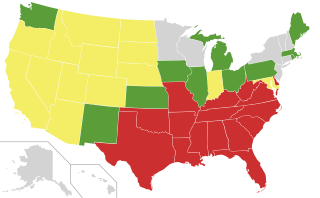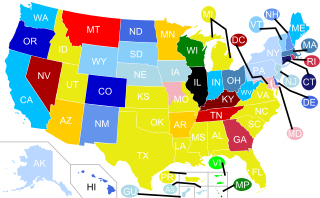 W
WThe Act for the relief of Indian Slaves and Prisoners, which was passed on March 7, 1852 in the Utah Territory, dealt with Indian slavery. A similar law, the Act in Relation to Service, which had made slavery legal in the territory, had been passed on February 4, 1852.
 W
WThe Act in Relation to Service, which was passed on Feb 4, 1852 in the Utah Territory, made slavery legal in the territory. A similar law, Act for the relief of Indian Slaves and Prisoners was passed on March 7, 1852, and specifically dealt with Indian slavery.
 W
WIn the United States, anti-miscegenation laws were laws passed by most states that prohibited interracial marriage and interracial sexual relations. Some such laws predate the establishment of the United States, some dating to the later 17th or early 18th century, a century or more after the complete racialization of slavery. Most states had repealed such laws by 1967, when the U.S. Supreme Court ruled in Loving v. Virginia that such laws were unconstitutional in the remaining 16 states. The term miscegenation was first used in 1863, during the American Civil War, by journalists to discredit the abolitionist movement by stirring up debate over the prospect of interracial marriage after the abolition of slavery.
 W
WThe Banking Act of 1933 was a statute enacted by the United States Congress that established the Federal Deposit Insurance Corporation (FDIC) and imposed various other banking reforms. The entire law is often referred to as the Glass–Steagall Act, after its Congressional sponsors, Senator Carter Glass (D) of Virginia, and Representative Henry B. Steagall (D) of Alabama. The term Glass–Steagall Act, however, is most often used to refer to four provisions of the Banking Act of 1933 that limited commercial bank securities activities and affiliations between commercial banks and securities firms. That limited meaning of the term is described in the article on Glass–Steagall Legislation.
 W
WThe Bankruptcy Act of 1898 was the first United States Act of Congress involving bankruptcy to give companies an option of being protected from creditors. Previous attempts at federal bankruptcy laws had lasted, at most, a few years.
 W
WThe Bankruptcy Act of 1938, also known as the Chandler Act, expanded voluntary access to the bankruptcy system in the United States and made voluntary petitions more attractive to debtors. It also gave authority to the Securities and Exchange Commission in the administration of bankruptcy filings. One effect was to remove investment banks from control of the corporate reorganization process by eliminating the equity receivership technique. Instead, a trustee was appointed by the bankruptcy court to oversee the reorganization process.
 W
WThe Black Codes, sometimes called Black Laws, were laws governing the conduct of African Americans. The best known of them were passed in 1865 and 1866 by Southern states, after the American Civil War, in order to restrict African Americans' freedom, and to compel them to work for low wages. Although Black Codes existed before the Civil War and many Northern states had them, it was the Southern U.S. states that codified such laws in everyday practice. In 1832, James Kent wrote that "in most of the United States, there is a distinction in respect to political privileges, between free white persons and free coloured persons of African blood; and in no part of the country do the latter, in point of fact, participate equally with the whites, in the exercise of civil and political rights."
 W
WThe Byrd Amendment—named for its author, Senator Harry F. Byrd Jr. of Virginia—was a 1971 amendment to the U.S. Federal Strategic and Critical Materials Stock Piling Act. It prohibited the US government from banning the importation of any strategic material from a non-communist country as long as the importation of the same materials from communist countries was also not prohibited. While it did not single out any particular country, it had the effect–intended by its sponsors–of creating an exception in the United States embargo of Rhodesia to enable the import of chromite ore from that country.
 W
WThe Cable Act of 1922 was a United States federal law that partially reversed the Expatriation Act of 1907. (It is also known as the Married Women's Citizenship Act or the Women's Citizenship Act). In theory the law was designed to grant women their own national identity; however, in practice, as it still retained vestiges of coverture, tying a woman's legal identity to her husband's, it had to be amended multiple times before it granted women citizenship in their own right.
 W
WThe Chinese Exclusion Act was a United States federal law signed by President Chester A. Arthur on May 6, 1882, prohibiting all immigration of Chinese laborers. Building on the 1875 Page Act, which banned Chinese women from immigrating to the United States, the Chinese Exclusion Act was the first, and remains the only law to have been implemented, to prevent all members of a specific ethnic or national group from immigrating to the United States.
 W
WConvict leasing was a system of forced penal labor which was historically practiced in the Southern United States and overwhelmingly targeted African-American men. Recently, a form of the practice has been instituted in western states. In the earlier forms of the practice, convict leasing provided prisoner labor to private parties, such as plantation owners and corporations. The lessee was responsible for feeding, clothing, and housing the prisoners.
 W
WThe Dawes Act of 1887 regulated land rights on tribal territories within the United States. It authorized the President of the United States to subdivide Native American tribal communal landholdings into allotments for Native American heads of families and individuals. This would convert traditional systems of land tenure into a government-imposed system of private property by forcing Native Americans to "assume a capitalist and proprietary relationship with property" that did not previously exist in their cultures. The act would declare remaining lands after allotment as "surplus" and available for sale, including to non-Natives. Before private property could be dispensed, the government had to determine "which Indians were eligible" for allotments, which propelled an "official search for a federal definition of Indian-ness."
 W
WThe Edmunds–Tucker Act of 1887 was an Act of Congress that focused on restricting some practices of The Church of Jesus Christ of Latter-day Saints. An amendment to the earlier Edmunds Act, it was passed in response to the dispute between the United States Congress and the LDS Church regarding polygamy. The act is found in US Code Title 48 & 1461, full text as 24 Stat. 635, with this annotation to be interpreted as Volume 24, page 635 of United States Statutes at Large. The act is named after its congressional sponsors, Senator George F. Edmunds of Vermont and Congressman John Randolph Tucker of Virginia.
 W
WThe Expatriation Act of 1907 was an act of the 59th United States Congress concerning retention and relinquishment of United States nationality by married women and Americans residing abroad. It effectively functioned as Congressional endorsement of the various ad hoc rulings on loss of United States nationality that had been made by the State Department since the passage of the Expatriation Act of 1868. Some sections of it were repealed by other acts in the early 1920s; those sections which remained were codified at 8 U.S.C. §§ 6–17, but those too were repealed by the Nationality Act of 1940. when the question of dual citizenship arose.
 W
WThe Food and Fuel Control Act, Pub.L. 65–41, 40 Stat. 276, enacted August 10, 1917, also called the Lever Act or the Lever Food Act was a World War I era US law that among other things created the United States Food Administration and the United States Fuel Administration.
 W
WThe Immigration Act of 1924, or Johnson–Reed Act, including the Asian Exclusion Act and National Origins Act, was a United States federal law that prevented immigration from Asia, set quotas on the number of immigrants from the Eastern Hemisphere, and provided funding and an enforcement mechanism to carry out the longstanding ban on other immigrants.
 W
WJim Crow laws were state and local laws that enforced racial segregation in the Southern United States. These laws were enacted in the late 19th and early 20th centuries by white Southern Democrat-dominated state legislatures to disenfranchise and remove political and economic gains made by black people during the Reconstruction period. The Republican Party lily-white movement supported the exclusion of African Americans. The Jim Crow laws were enforced until 1965.
 W
WThe National Maximum Speed Limit (NMSL) was a provision of the federal government of the United States 1974 Emergency Highway Energy Conservation Act that effectively prohibited speed limits higher than 55 miles per hour (89 km/h). It was drafted in response to oil price spikes and supply disruptions during the 1973 oil crisis and remained the law until 1995.
 W
WThe Naturalization Act of 1790 was a law of the United States Congress that set the first uniform rules for the granting of United States citizenship by naturalization. The law limited naturalization to "free white person[s] ... of good character", thus excluding Native Americans, indentured servants, slaves, free blacks and later Asians, although free blacks were allowed citizenship at the state level in a number of states.
 W
WThe Naturalization Act of 1798 passed by the United States Congress, to amend the residency and notice periods of the previous Naturalization Act of 1795. It increased the period necessary for aliens to become naturalized citizens in the United States from 5 to 14 years and the Declaration of Intention from 3 to 5 years.
 W
WThe Page Act of 1875 was the first restrictive federal immigration law in the United States, which effectively prohibited the entry of Chinese women, marking the end of open borders. The 1882 Chinese Exclusion Act would go on to ban immigration by Chinese men as well.
 W
WThe Pittman Underground Water Act was an Act of Congress, that was approved on October 22, 1919 and was repealed on August 11, 1964. The public law gave the Secretary of the Interior the power to hand out permits to American citizens and associations to drill for and look for groundwater on public lands in Nevada. In addition, the law gave the Secretary the power to give patents to permittees who found enough groundwater to sustain a farm. The law was supposed to stimulate agriculture in Nevada by supporting the development of artesian waters, since it was thought that the absence of surface water undermined the growth of the agricultural sector in Nevada.
 W
WThe Public Utility Holding Company Act of 1935 (PUHCA), also known as the Wheeler-Rayburn Act, was a US federal law giving the Securities and Exchange Commission authority to regulate, license, and break up electric utility holding companies. It limited holding company operations to a single state, thus subjecting them to effective state regulation. It also broke up any holding companies with more than two tiers, forcing divestitures so that each became a single integrated system serving a limited geographic area. Another purpose of the PUHCA was to keep utility holding companies engaged in regulated businesses from also engaging in unregulated businesses. The act was based on the conclusions and recommendations of the 1928-35 Federal Trade Commission investigation of the electric industry. On March 12, 1935, President Franklin D. Roosevelt released a report he commissioned by the National Power Policy Committee. This report became the template for the PUHCA. The political battle over its passage was one of the bitterest of the New Deal, and was followed by eleven years of legal appeals by holding companies led by the Electric Bond and Share Company, which finally completed its breakup in 1961.
 W
WIn 1924, the Virginia General Assembly enacted the Racial Integrity Act. The act reinforced racial segregation by prohibiting interracial marriage and classifying as "white" a person "who has no trace whatsoever of any blood other than Caucasian." The act, an outgrowth of eugenist and scientific racist propaganda, was pushed by Walter Plecker, a white supremacist and eugenist who held the post of registrar of Virginia Bureau of Vital Statistics.
 W
WThe Salus-Grady libel law, also known as the Pennsylvania anti-cartoon law, was enacted by the Commonwealth of Pennsylvania in 1903 to discourage political criticism from the press. Governor Samuel W. Pennypacker championed the controversial law in response to an ongoing set of cartoons that mocked his successful 1902 gubernatorial campaign and his tenure as governor. Upset by being caricatured as a parrot, Pennypacker denounced what he deemed "the sensational devices and the disregard of truth" employed by the press. The law broadened the circumstances under which a newspaper could be sued for libel, and made editors liable in their personal capacity to such lawsuits. Rather than having the chilling effect Pennypacker desired, the law backfired spectacularly. Charles Nelan and other artists drew cartoons more contemptuous than the previous ones, and nationally circulating newspapers joined the Pennsylvanian newspapers in protesting against the law. The law languished along with Pennypacker when he stepped down from office in 1907, as his successor quickly repealed the controversial measure.
 W
WThe Sedition Act of 1918 was an Act of the United States Congress that extended the Espionage Act of 1917 to cover a broader range of offenses, notably speech and the expression of opinion that cast the government or the war effort in a negative light or interfered with the sale of government bonds.
 W
WSodomy laws in the United States, which outlawed a variety of sexual acts, were inherited from colonial laws in the 1600s. While they often targeted sexual acts between persons of the same sex, many statutes employed definitions broad enough to outlaw certain sexual acts between persons of different sexes, in some cases even including acts between married persons.